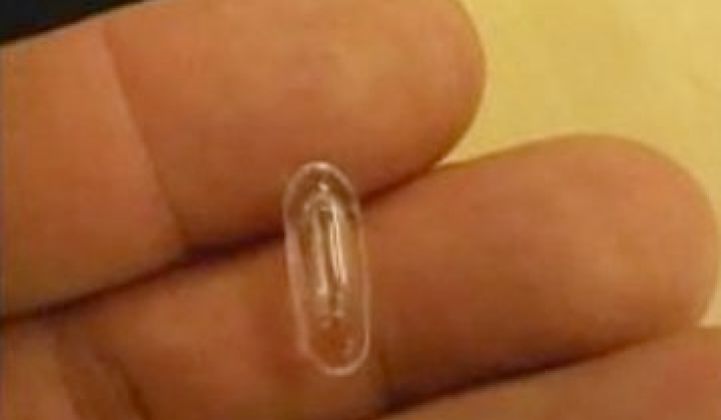LEDs have helped kick off the ongoing revolution in lighting, but they aren't perfect for every occasion, says Greg Barry, CEO of Topanga Technologies.
Topanga is in the midst of putting the final design changes on a plasma bulb that it says can roughly half the power and maintenance costs associated with high intensity discharge (HID) lights, those intense bulbs that illuminate tennis courts, streets, garages and big box retailers. Ordinarily, HID lighting costs $12.50 in electricity and maintenance per 1,000 lumens of light a year. Topanga will do the job for $6.50 per 1,000 lumens.
"And it's fully dimmable from 100 percent to 20 percent," said Barry. He brought a sample with him, and you can take our word for it: it's bright.
Like Luxim, Topanga's core technology revolves around using radio frequency waves to excite molecules trapped in a clear chamber. The chamber is about as big as a breath mint and looks like something from a Christmas tree. In about thirty seconds, the small bulb emits enough light to illuminate several rooms. In a sense, both Luxim's and Topanga's bulbs operate under a supersized version of the principle -- chemical excitation -- that animates fluorescent lights. LEDs, by contrast, are solid-state lights: light gets emitted by a chip.
A number of different solutions -- electronic ballasts from companies like HID Labs, LED streetlights, plasma lights -- have been proposed in recent years to cut power in the HID market. Government mandates and high power prices have driven these changes. To date, LED has made the most progress (check out the warehouse LED lights from Digital Lumens), but it remains something of an open market.
Luxim has marketed its bulbs for years and branched out into street lighting in 2008. What is Topanga going to offer that's different than Luxim? The resonator, which concentrates the radio frequency waves for the bulb, is hollow, he said, whereas Lumix has a solid resonator. Additionally, Topanga claims it will be cheaper to swap out its bulbs -- though a Luxim representative refuted the 'cheaper' part. (The photo shows a Luxim bulb and two of my fingers. Topanga showed me their bulb and electronics but pictures were not allowed.) More importantly, the question is what can these companies offer over LEDs?
Plasma lighting, Barry added, has an advantage over LEDs in HID applications because of the vast quantity of light that they can produce. To emit 10,000 lumens or more, LED fixture makers need to put 200 LEDs into a fixture, which adds weight and creates a challenge for dissipating the heat that emerges from the back of each LED. HID lights emit 15,000 to 30,000 lumens and can emit up to 90,000 lumens. (Note: LED makers will argue that point.)
"In LEDs, you can get hundreds of thousands of hours of light," Barry explained. "The driver only lasts 30,000 hours. Here you have the opposite problem. The lamp only lasts 30,000 hours but the drivers last longer."
Another problem with LEDs: the technology seems to have occupied all of the intellectual bandwidth at the Department of Energy. It has become tough for alternative light technologies to get funding.
Still, LEDs do deserve credit for something. These lights have grabbed the attention of customers and electronics manufacturers, which in turn has prompted lighting companies to respond with new products. Typically, the lighting industry has been somewhat slow moving. A company might come out with a new product, but then evolve it slowly because of apparent customer indifference.
"There hasn't been a lot of changes in the lighting business in the last 60 years. You got a little bit of change with CFLs in the '90s," he said. "But we've seen more changes in the last five years than in the previous 60. If LEDs hadn't come along, technologies like this might not have happened."
The company has landed five patents, has 25 pending, and is gearing up to file 23 more applications. Khosla Ventures and Nth Power have both invested in the company. Ford Tamer, who just left Khosla Ventures, will remain on the board.



